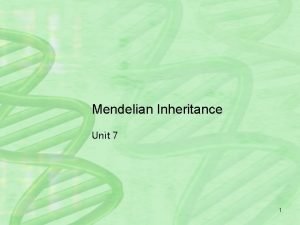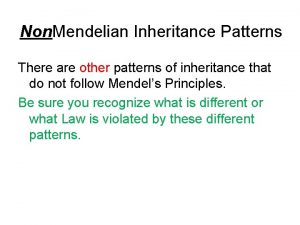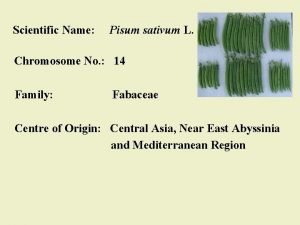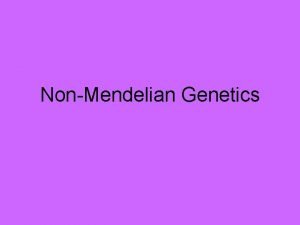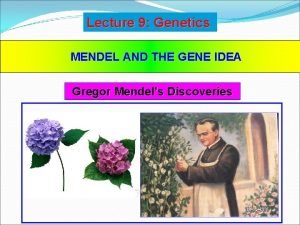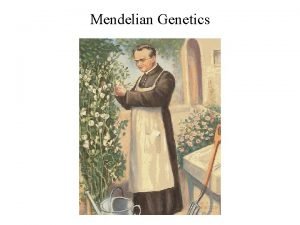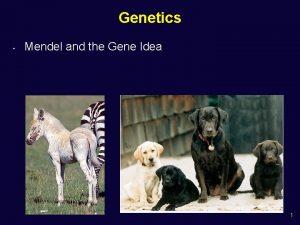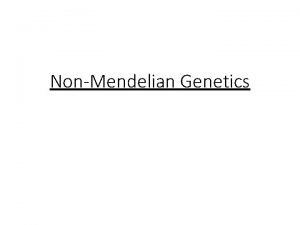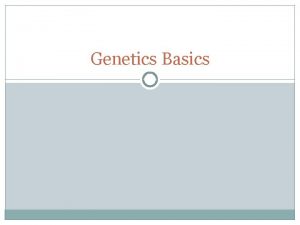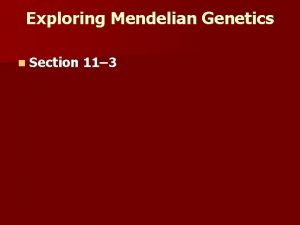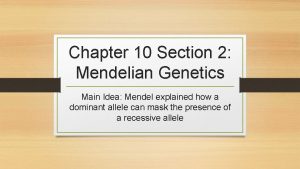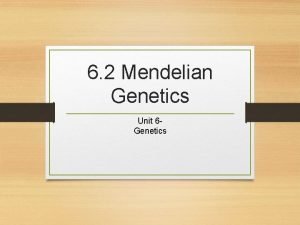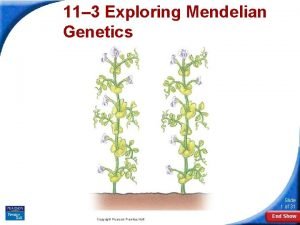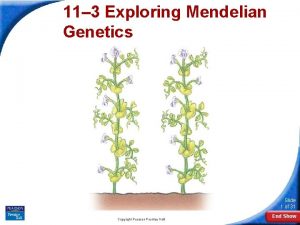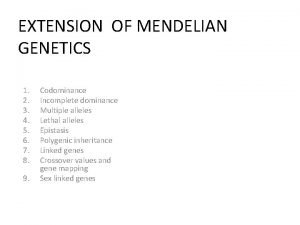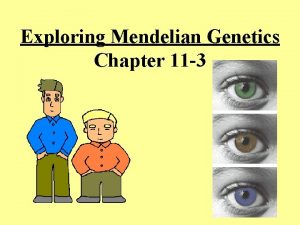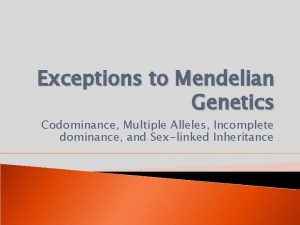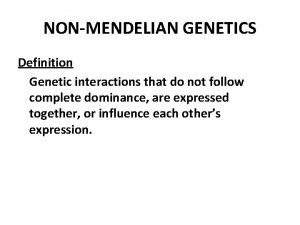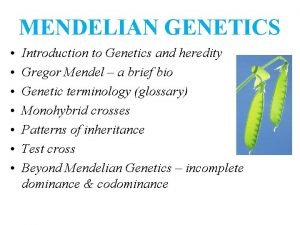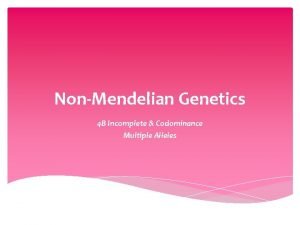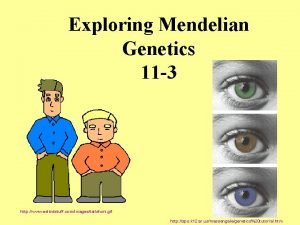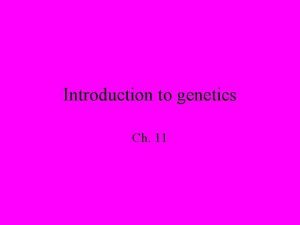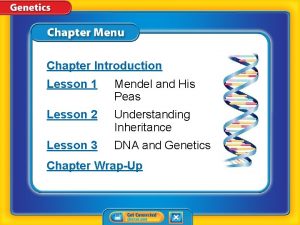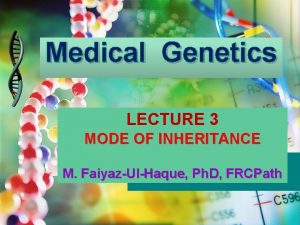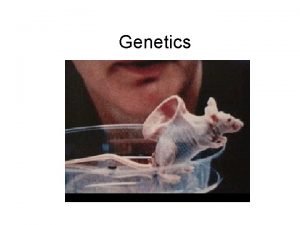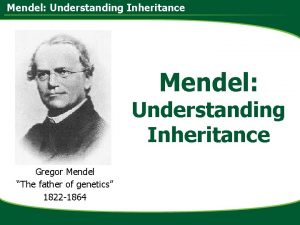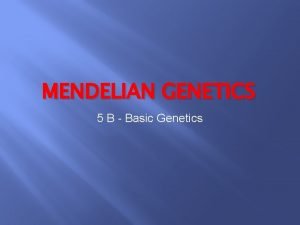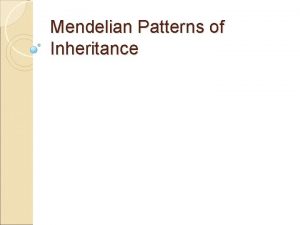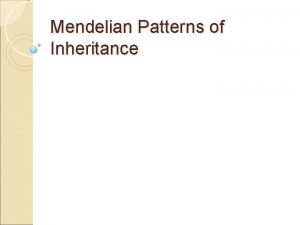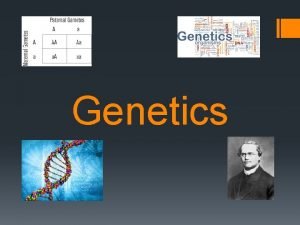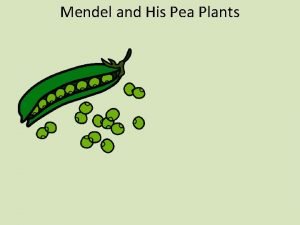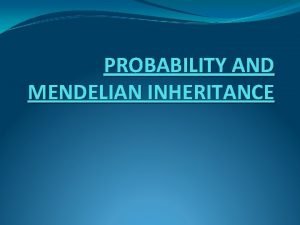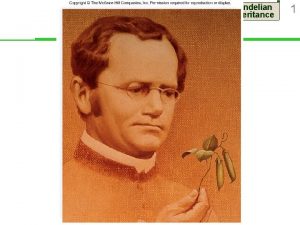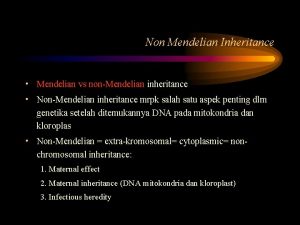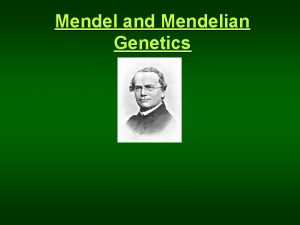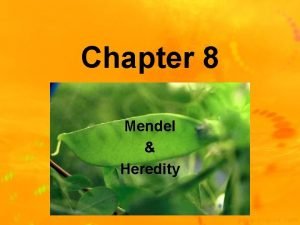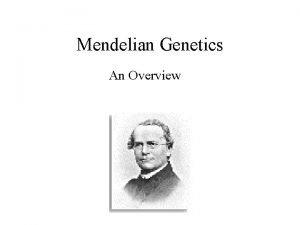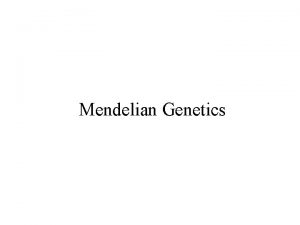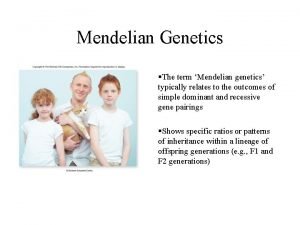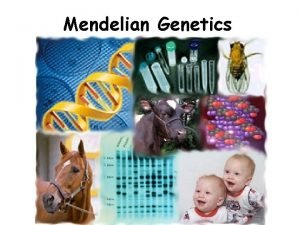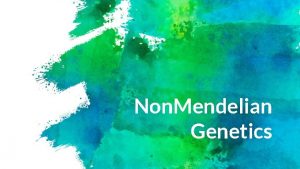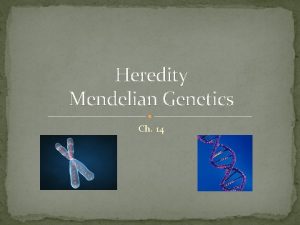Mendelian Genetics Mendel Pea Plants and Inheritance Patterns


































- Slides: 34

Mendelian Genetics

Mendel, Pea Plants, and Inheritance Patterns Mendel spent most of his adult life in Brno, a city near Vienna that is now part of the Czech Republic. His monastery was close to European capitals that were centers of scientific inquiry. Having been raised on a farm, he was keenly aware of agricultural principles and their applications, and kept abreast of literature on breeding experiments. He belonged to an agricultural society and won awards for developing improved varieties of vegetables and fruit.

Mendel, Pea Plants, and Inheritance Patterns After entering the monastery Mendel took courses in mathematics, physics, and botany at the University of Vienna. Few scholars of his time showed interest in both plant breeding and mathematics. Shortly after his university training, Mendel started to study Pisum stivum, the garden pea plant.

Mendel, Pea Plants, and Inheritance Patterns Why the pea plant? The plant is self-fertilizing. It’s flowers produce both male and female gametes. One lineage of plants can “breed true” This means that successive generations will be like parents in one or more traits, as when all offspring grown from seeds of self -fertilized, white flowered parent plants also have white flowers. Pea plants can also cross-fertilize when plant breeders transfer pollen from one plant to the flower of another plant. Breeders open a floral bud of a plant that bred true for white flowers or some other trait and snip out its stamens. Now it cannot produce its own pollen. Now, the buds can be brushed with pollen from a plant that bred true for a different version of the trait —say, purple flowers.

Mendel, Pea Plants, and Inheritance Patterns As Mendel hypothesized, such clearly observable differences might help him track a given trait through many generations. If there were patterns to the trait’s inheritance, then those patterns might tell him something about heredity itself.

Terms Used In Modern Genetics In Mendel’s time, no one knew about genes, meiosis, or chromosomes. However, in order for you to understand genetics, you must know the following terms. Genes Units of information on heritable traits, which parents transmit to offspring. For example: eye color Each gene has a specific location (locus) in chromosomal DNA.

Terms Used In Modern Genetics Diploid Pairs of genes (2 n) on homologous (coding for the same characteristics—like eye color) chromosomes. Mutation Alters a gene’s molecular structure and its message about a trait. May cause a trait to change, as when a gene for flower color specifies yellow and a mutant form of the gene specifies white. Alleles All molecular forms of a the same gene. For example, eye color can range from blue to green to brown to any number of combinations thereof.

Terms Used in Modern Genetics Pure bred or true-breeding When offspring inherit a pair of identical alleles for a trait generation after generation. For example: Pugs are true- breeding. Each generation has the same coat color, body type, personality, etc. Hybrid Offspring of a cross between two individuals that breed true for different forms of a trait. Each one has inherited nonidentical alleles for the trait. For example: Puggles are a combination of pure-bred beagles and pure-bred pugs. They will display a combination of the traits from each breed.

Terms Used in Modern Genetics Homozygous A pair of identical alleles on a pair of homologous chromosomes. For example: A child inherits the alleles for brown eyes from both parents (BB) Heterozyous A pair of non-identical alleles on a pair of homologous chromosomes. For example: A child inherits the alleles for brown eyes from his mother and blue eyes from his father (Bb).

Terms Used In Modern Genetics Dominant An allele that masks the effect of any recessive allele paired with it. Capital letters signify dominant alleles. For example: A child inherits the alleles for brown eyes from his mother and blue eyes from his father (Bb), but will display brown eyes. Recessive An allele that requires homozygous in heritance to show up physically. For example: A child inherits the alleles for blue eyes from both parents (bb) and displays blue eyes.

Terms Used in Modern Genetics Homozygous dominant BB BB An individual has a pair of dominant alleles (BB) for the trait under study. bb BB bb Homozygous recessive BB An individual has a pair of recessive alleles (bb). Heterozygous An individual has a pair bb bb BB bb of non-identical alleles (Bb). Bb Bb

Terms Used In Modern Genetics Genotype bb Refers to the particular alleles that an individual carries. For example: BB, bb, Bb Phenotype Refers to an individual’s observable traits. For example: Brown eyes or blue eyes. Blue eyes

Mendel’s Experimental Approach For Mendel’s experiments, PP he coded each generation of plants with a different letter. P = true-breeding parents. Example: Mom (PP) and Dad (pp) F 1 = first generation Pp P F 1 pp Pp offspring For example: Child (Pp) F 2 = second generation offspring of self-fertilized or cross-fertilized F 1 individuals. For example: Grandchild can either be (PP), (Pp), or (pp). PP F 2 Pp pp

Mendel’s Theory of Segregation Mendel used monohybrid PP X pp (Parental) experiments to test a hypothesis: Pea plants inherit two “units” of information (genes) for a trait, one from each parent. P P p Pp Pp In monohybrid experiments, two homozygous parents differ in a trait that is governed by alleles of one gene (like flower color). They are crossed to produce F 1 offspring that are all heterozygous. Pp

Monohybrid Experiment Predictions Mendel tracked seven traits for two generations. Pp X Pp (F 1 generation) In one set of experiments, he crossed plants that bred true for purple or white flowers. (P) All F 1 offspring had purple flowers. In the next generation (F 2), some offspring had white flowers. P p Mendel was confused, what was going on? Mendel crossed seventy plants, and recorded the number of dominant and recessive forms of traits in thousands of offspring. On average, 3 out 4 F 2 plants were dominant, and one was recessive. o The ratio hinted that fertilization is a chance event having a number of possible outcomes. P PP Pp pp

Monohybrid Experiment Predictions Mendel knew that the principles of probability, which applied to chance events, could help him predict possible outcomes of genetic crosses. Probability The chance that each outcome of an event will occur is proportional to the number of ways in which the outcome can be reached. Mendel had to do all his probability problems by hand, but thanks to Reginald C. Punnett, we have the Punnett square to help us figure out genetic probabilities. Yay Punnett! Probability is written as 3: 4: 5: 6: 7…

Monohybrid Experiment Predictions Mendel’s experiments crossing two true breeding parents would look like this: (yes, write this down) Mom plant has (PP) for purple flowers. Dad plant has (pp) for white flowers. p p P P Pp Pp All the offspring (F 1) are heterozygous. The probability for purple flowers in this generation is 4: 0.

Monohybrid Experiment Predictions Mendel’s next experiments (F 1) would look like this: Mom plant is Pp. Dad plant is Pp. P p P PP Pp pp The resulting offspring have a 3: 1 chance (probability) of inheriting a dominant allele (purple). A hint on probability: it will always add up to the number of squares in the Punnett square, so if you come up with 3: 2 (which equals 5), your probability is off!

Testcrosses help determine whether organisms of an unknown genotype, but who show dominant characteristics, will have Pp or PP. • Unknown genotype (P? )--will show purple flowers • Recessive genotype (pp)–will show white flowers p P ? Pp ? p By crossing an unknown dominant(P? ) with a known recessive individual (pp), genotypes can be figured out! p Pp ? p If 50% of the offspring are white, then the unknown is Pp, if none of the offspring are white, the unknown is PP

Theory of Segregation In modern terms, theory of segregation is: Diploid cells have pairs of genes (one from each parent) on homologous chromosomes. The two genes of each pair are separated from each other during meiosis, so they end up in different gametes. Pp In other words, if you have inherited purple flowers (P) from one parent and white flowers (p) from another parent, your eggs/sperm will contain the allele for EITHER purple (P) or white (p). Not both. The pollen (plant sperm) will each receive either P or p The ovum(plant eggs) will each receive either P or p

Theory of Independent Assortment Mendel was wondering how two genes (like purple flowers and round seeds) are sorted into gametes. Do they sort together, i. e. every time a plant gets purple flowers, it gets round seeds, or separately? In order to figure this out, he did dihybrid experiments.

Dihybrid Experiments Dihybrid experiments follow two different traits from one generation to the next. They start with a cross between true-breeding homozygous parents that differ in two traits (i. e. flower color and seed shape) governed by alleles of two genes. Parent 1: Purple flowers and Round seeds (PPRR) Both are dominant traits. Parent 2: white flowers and wrinkled seeds (pprr) Both are recessive traits. NOW, you must find all the different combinations that the two parents can make. Parent 1: PR Parent 2: pr

Dihybrid Experiment Parent 1: PPRR PR PR pr P p. R r P p Rr pr P p Rr P p Rr Pp Rr pr P p Rr Pp Rr Parent 2: pprr Each offspring turns out to be a hybrid for both flower color and pea shape. Notice that each square has 4 letters and two alleles for each trait!

Dihybrid Experiment Now, Mendel crossed P p R r two of the F 1 generation. Plant 1: Pp. Rr Plant 2: Pp. Rr Before you can start the dihybrid cross, you must figure out all the possible combinations. PR Pr p. R pr

Dihybrid Experiment Parent 1: Pp. Rr The four resulting phenotypes are purple and round, purple and wrinkled, white and round, white and wrinkled. PR Pr p. R pr PR PP Rr Pp RR Pp Rr Pr PP Rr P P rr Pp Rr Pp r r Purple and round = 9 Purple and wrinkled = 3 White and round = 3 White and wrinkled = 1 p. R Pp Rr p p RR p p Rr The ratio will be 9: 3: 3: 1 pr Pp Rr pp pp r r Pp rr Rr

Theory of Independent Assortment Mendel’s dihybrid experiments pointed to the fact that traits are not (usually) linked. Meaning that a plant can have purple flowers with wrinkled seeds or purple flowers and round seeds. OR, you can have brown hair and brown eyes, or brown hair and blue eyes, as the two traits are NOT linked together. Flower color and seed shape are NOT linked.

Theory of Independent Assortment In modern terms, theory of independent assortment is: Brown hair Blue eyes As meiosis ends, genes on pairs of homologous chromosomes have been sorted out for distribution into one gamete or another, independently of gene pairs on other chromosomes. In other words, when you make eggs/sperm, your offspring can have many different combinations of traits. They do not HAVE to have brown eyes, simply because they have brown hair, as the two traits are independent of one another. o This theory is MOSTLY true, but now we know that some traits ARE linked, like red hair and freckles. Blond hair Brown eyes

Unexpected Patterns Mendel just happened to focus on traits that have clearly dominant or recessive forms. However, expression of genes for some traits is not as straightforward.

Codominance In codominance, a pair of non- identical alleles affecting two phenotypes are both expressed at the same time in heterozygotes. MOM Yy DAD BB These are for traits where there is more than one dominant option (like eye color!) For example, if one of your parents has yellow hair, and the other has blue, and you get (YB) for hair color, then you will have both blue and yellow hair! Both traits show up. YB YB

Codominance in real life! Red blood cells have a type of glycolipid on their plasma membrane that give them their unique identity. The glycolipid comes in slightly different forms: A, B, or O. An enzyme dictates the glycolipid’s final structure. Three alleles for this enzyme are present in all populations! Both A and B blood types are dominant. O is recessive. They are written as IA, IB, and i. The occurrence of three or more alleles for a single gene among individuals of a population is called a multiple allele system!

Codominance in real life! If you inherit IAIA or IAi, you will have A blood type. 40 % of the US population has Type A blood. They can receive both Type A and Type O blood in an emergency. If you inherit IBIB or IBi, you will have B blood type. 11% of the US population has Type B blood. They can receive both Type B and Type O blood in an emergency. If you inherit ii, you will have O blood type. 45% of the US population has Type O blood. They can only receive type O blood, but they are universal donors! Because both A and B are dominant alleles, if you inherit IAIB, you will have AB blood type. 4% of the US population has Type AB blood. They can receive both Type AB, Type A, Type B blood and O blood in an emergency—They are

Incomplete Dominance In incomplete dominance, one allele of a pair is not fully dominant over its partner, so the heterozygote’s phenotype is somewhere between the two homozygotes. MOM bb DAD Bb For example, if one of your parents has yellow hair, and the other has blue, and you get (Bb) for hair color, then you will have green hair! A combination of the two! Bb Bb

Incomplete Dominance in real life! When true-breeding (pure bred) red and white snapdragons are bred together, their offspring end up being pink. Red snapdragons have two alleles that left them make a lot of molecules of red pigment. White snapdragons have two mutant alleles and are pigmentfree. Pink snapdragons have a “red” allele and a “white” allele; and make just enough pigment to color the flowers pink.

Genes and the Environment The environment can affect the expression of genes in surprising ways. For example, the himalayan rabbit is homozygous for an enzyme that is heat sensitive. In the winter, this enzyme causes the rabbit to grow white fur, in the summer, the enzyme causes the rabbit to grow black fur. In humans, you may have genes that dictate tallness, but if you don’t get enough food to eat during development, you may end up short. All three of these children display the symptoms of Rickets disease. Rickets is the softening of the long bones due to deficiency in the diet or impaired metabolism.
 Difference between mendelian and non mendelian inheritance
Difference between mendelian and non mendelian inheritance Mendelian inheritance patterns
Mendelian inheritance patterns L
L Non mendelian inheritance
Non mendelian inheritance Cystic fibrosis mendelian inheritance
Cystic fibrosis mendelian inheritance Probability laws govern mendelian inheritance
Probability laws govern mendelian inheritance 3 laws of inheritance
3 laws of inheritance What are mendelian traits
What are mendelian traits In watermelons bitter fruit (b) is dominant
In watermelons bitter fruit (b) is dominant Is baldness a sex linked trait
Is baldness a sex linked trait Section 11-4 meiosis answer key
Section 11-4 meiosis answer key Heterozygous for type a blood
Heterozygous for type a blood Extending mendelian genetics
Extending mendelian genetics Section 11-3 exploring mendelian genetics
Section 11-3 exploring mendelian genetics Chapter 10 section 2 mendelian genetics
Chapter 10 section 2 mendelian genetics Mendelian genetics punnett square
Mendelian genetics punnett square Section 11-3 exploring mendelian genetics answers
Section 11-3 exploring mendelian genetics answers 11-3 exploring mendelian genetics answers
11-3 exploring mendelian genetics answers Holandric genes
Holandric genes Pprr x pprr punnett square
Pprr x pprr punnett square Section 11-3 exploring mendelian genetics answer key
Section 11-3 exploring mendelian genetics answer key Exceptions to mendelian genetics
Exceptions to mendelian genetics Chapter 7 extending mendelian genetics vocabulary practice
Chapter 7 extending mendelian genetics vocabulary practice What is incomplete dominance simple definition
What is incomplete dominance simple definition Test cross
Test cross Mendelian genetics
Mendelian genetics Mendelian genetics vocab
Mendelian genetics vocab Codominance
Codominance Chapter 7 extending mendelian genetics answer key
Chapter 7 extending mendelian genetics answer key Mendelian genetics concept map
Mendelian genetics concept map Chapter 7 extending mendelian genetics vocabulary practice
Chapter 7 extending mendelian genetics vocabulary practice 11-3 exploring mendelian genetics
11-3 exploring mendelian genetics Mendel's first and second law of inheritance
Mendel's first and second law of inheritance Altura de andrew garfield
Altura de andrew garfield Mendel's 3rd law of inheritance
Mendel's 3rd law of inheritance
